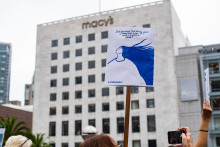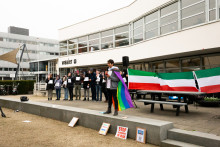Following the murder of 22-year-old Zhina (Mahsa) Amini by Iranian religious morality police in September, new protests have broken out in Iran and are the subject of the open meeting. 'The motto of this movement is Women, Life, Freedom, and it stands in opposition to the patriarchy that has dominated Iran since the 1979 Islamic Revolution,' explained speaker and assistant professor in the Department of Philosophy at UT, Yashar Saghai, during the meeting.
According to one of the other speakers, Azadeh Akbari (assistant professor of Public Administration and Digital Transformation at UT), the feminist movement did not come out of nowhere. 'This is not just a political movement against the Iranian regime, but ultimately the continuation of the decades-long struggle of women against patriarchy.’ Even though the bloody protests in Iran have caused many Iranians to despair, Akbari stated that these protests are of real value to women in Iran. 'It has taken many years of women trying everything to get other people in Iran to support them, and now it is finally happening.'
Protests
The Iranian government has faced protests before, but according to Saghai, the current protests are having a very different effect. 'We had protest movements, but they were aimed at reforms, now the protests are directly directed against the very existence of the Islamic Republic.’ Moreover, Saghai points out, these protests show that the Iranian people do not obey the government's rule. 'Despite 43 years of propaganda, the Iranian people still have not accepted the regime.’
The Iranian government appears to be cracking down hard on these protests. 'There is torture and persecution of protesters, including very young school children,’ Saghai explained. Noting the dangers that protesters face in Iran, Saghai expressed his respect for those who take to the streets to demonstrate. 'We are impressed by the bravery of the men and women who are fighting for this cause.'
Myths about Iran
It was mentioned during the lecture that many people in the West have myths about the Iranian people that have to be dealt with in order to understand the situation in Iran. People in the West tend to think that Iranians are a relatively homogeneous group of people with more or less the same beliefs. In Saghai's view, this is a myth. 'Iran is a country with enormous religious and ethnic diversity. Just like people in the West, we have many different lifestyles.'
Another myth Saghai mentions is that the Islamic Republic was democratically elected by the Iranian people. 'The referendum was rigged because it was a referendum at gunpoint. People with guns threatened people to vote for the Islamic Republic.' In addition, some people believe that the ideas of feminism and democracy are a Western product adopted by some Iranians, which Saghai says is a myth: 'There has been a feminist movement in Iran for two centuries, and the ideas of secularism and liberal democracy have a long history in Iran.'
Technology
According to Akbari, the Iranian government is using various forms of new technology to enforce government regulations. One example is the use of AI in state-owned television stations. 'They have algorithms that have learned what kind of scenes need to be censored for Iranian television, for example, scenes showing certain body parts.’ Technology is used not only for censorship, but also to punish women who do not wear their hijab correctly. 'Traffic cameras in iran captured images of a woman not wearing the hijab correctly while driving. The footage was then used to punish this woman.’
Akbari suspects that the Iranian government is using facial recognition technology to prosecute women who do not wear their hijab. 'For the past two years, every Iranian has been required to have a biometric ID card. This facilitates surveillance because the government has a very good database of all faces and fingerprints. That's why people wear masks at demonstrations, they are aware of it.'
Supporting the cause
The speakers outlined various ways in which students can support the protesters' cause. These include talking to fellow Iranian students to offer emotional support and asking their universities to take a clear stance on the protests in Iran. According to Saghai, pressure should not only be put on the university to take a clear stance on Iran, but also on the student's local government. He argues that blacklisting and freezing assets of Iranian state officials is important to deprive the regime of financial resources. Saghai also sees an essential role in social media and especially in the spread of videos about and from the protests. 'The regime cares about its image outside Iran, so posts on social media showing what is really happening in Iran are important.’







